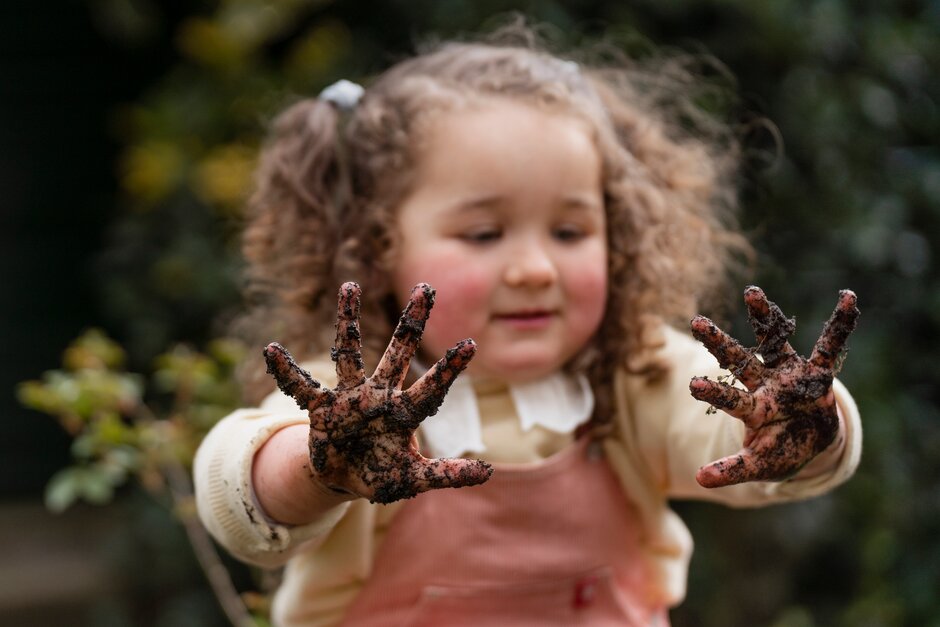Understanding the world
Let’s get muddy- playing with mud is great for learners and creating a dig pit in your setting can be a low-cost way to increase learners' connection to nature. Playing with mud is proven to boost the immune system and improve mental health. For learners, a dig pit can be a fantastic opportunity to introduce scientific enquiry whether they are interested in rocks, soil, plants or invertebrates.
Adult-led Activity Suggestions
- Enable learners to understand some important processes and changes in the natural world around them by dam building with puddles or in the water play area.
- Plant cress heads as an introduction to growing food. This could also be introduced as an enquiry by changing the amount of water or sunlight each cress head receives.
- Worm charming is for learners who feel confident in nature, encouraging them to search for worms in different locations around the school grounds. Best completed in a small group of learners who are particularly interested in life underground.
- The camouflage caterpillars food chain activity introduces the concept of a food chain to learners in a fun and exploratory way. Learners will hide different coloured pieces of wool around the playground. The learners then act as hungry blue tits and search for ‘worms’ to eat. Once played with an adult, children can be encouraged to play independently.
- Nature Park activity: Water permeability - this activity will allow learners to compare different surfaces in nature, and how they can contribute to reducing flooding. By exploring their site and experimenting with water, learners will notice how water interacts with each surface – does the water disappear? Does it pool and go somewhere else?
It is important for learners in the early years to be supported to explore the seasons. Most setting will observe the weather and seasons as part of their daily routine. These observations can be extended to include more enquiry. For example, you could place a bucket outside to collect water and measure the amount of water captured each week. Simple rainwater collection could be captured on a class bar chart of pictogram. After the measurement is complete children can be encouraged to use the collected water on a plant or tree. Other ways to investigate the weather are to hang wind chimes or a sundial.
Continuous Provision
The Dig Pit
It can be tricky to spot wildlife in an educational setting but there is a whole world of life right under our feet. Getting muddy and exploring underground can be a learner’s first real insight into how things in nature are interconnected. By interacting with soil learners begin to explore:
- Plant anatomy
- Rock formation
- Soil composition
- Living versus non-living things
- Safe tool use
- Changing states of matter
- Mini beasts (decomposers)
Creating The Dig Pit
A dig pit can be created in a small space. It is best to find a non-concreted area and clearly mark the digging zone with rope to ensure children are aware of the boundaries. The learning will evolve with the dig pit over time. If your setting has no natural surfaces, you could use an old tyre and fill it with soil and rocks, this could also be achieved indoors with a tuff tray.
Mini beasts or decomposers
It is likely that children will find insects whilst digging, providing the opportunity to discuss their role as decomposers. For example, worms eat dead things and turn them into soil. Soil helps plants to grow, and plants help to create clean air for us to breathe.
Posing 'I wonder’ questions can support learners to discuss the importance of worms:
- I wonder what would happen if there were no worms?
- I wonder if worms prefer dry or damp soil?
Remember to tell learners that it is safe to touch worms for a short period but to remain healthy and happy, they should largely remain wet and in the soil. Once learners have finished exploring the dig pit, they should be in the routine of washing their hands.
Useful Tools
- Trowel
- Watering can
- Spade
- Toothbrush
I wonder statements
- I wonder how many layers there are?
- I wonder what the soil is made up off?
- I wonder what the insects eat?
- I wonder how old this rock is?
Green Skill Development
- Identify and Ecology Skills
- Decision making and creative thinking.
- Environmental Stewardship and horticulture
- Communication

© RHS, Credit: RHS / Georgi Mabee
Early learning goal outcomes
- Explore the natural world around them, making observations and drawing pictures of animals and plants
- Know some similarities and differences between the natural world around them and contrasting environments, drawing on their experiences and what has been read in class
- Understand some important processes and changes in the natural world around them, including the seasons and changing states of matter